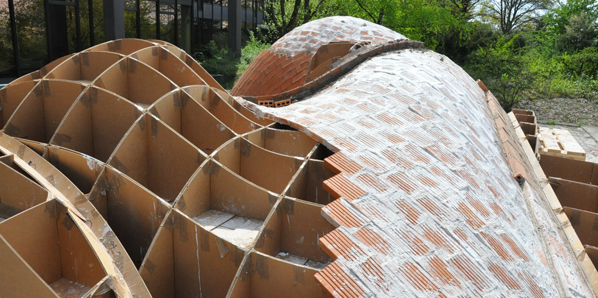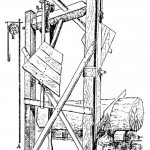Lara Davis, Matthias Rippman and Philippe Block from the Swiss BLOCK Research Group at the ETH Zurich University have taken the centuries old timbrel vaulting technique one step further by incorporating high-tech design tools (software and CNC fabrication) and low-tech materials (cardboard boxes and wooden palettes).
Find pictures and the research paper here or see the summary below.
Timbrel vaulting (also known as ‘Catalan vaulting’ or ‘thin-tile vaulting’) offers a sustainable roof and floor construction method because it uses fewer building materials than conventional techniques. Timbrel vaulting employs the use of good structural form to achieve a minimal shell thickness and requires no formwork. The new tools designed by the Swiss researchers aim to combine these advantages with a whole new range of complex shapes, which they call ‘freeform shells’:
“This research project presents important advances in timbrel vaulting, made possible through innovation in form finding, guidework systems and construction methods. A full-scale prototype has been realized with the application of new research in the following areas: newly developed structural design tools based upon the Thrust Network Approach (TNA), which allow one to generate novel shapes for funicular (i.e. compression-only) structures; an efficient cardboard box guidework system, which allows for a vaulted surface to be described in an accurate manner in space for the mason; and adaptations upon traditional timbrel vaulting techniques, which have introduced strategies for continuous tiling patterns, shell thickening, and sequencing for structural stability during construction.”
Matthias Rippmann designed both the prototype and the software tool, which is free to download:
“RhinoVAULT is software that allows for the intuitive design of compression-only shapes, offering a maximum control of the geometry. This software is written particularly for shaping unreinforced masonry vaults, but can also be used for designing efficient freeform shells. Based on the Thrust Network Approach (TNA), which uses a force network as discretization of the shape, it is possible to internally redistribute forces within the network using force diagrams. This enables the user to generate exciting forms far beyond typical ‘hanging-net’ morphologies.”
Contrary to the traditional timbrel vaulting techniques, these new forms require a continuous formwork system. While this approach seems to negate the inherent material and labour efficiency of thin-tile vaulting, the researchers introduce a formwork system using cardboard that still possesses the material economy of the traditional Catalan shell:
“The cardboard formwork implemented in this project is fabricated with 2-D CAD-CAM cutting and gluing processes and is assembled on site. The system’s rapid fabrication, lightweight transportation, and speed of erection and de-centering dramatically reduce the material and labour-based costs of construction. An inexpensive and potentially reusable/recyclable material, this lightweight cardboard formwork extends the viability of thin-tile vaulting to freeform construction.”
The formwork system is expandable, essentially composed of simple boxes supported by stacked shipping palettes. Using palettes for the first rough approximation of the final vault shape offers several advantages: it reduces the volume of cardboard to be used, it facilitates easy access during construction as the palettes can be arranged in step-like configuration, and it decreases the size of the boxes, ensuring that the unrolled cutting pattern of boxes fit to the limited machine-size of the CNC cutting machine.
A particular challenge is de-centering, which is the process of removing the formwork from the surface of the shell. This is a sensitive process, because the entire formwork should be removed equally and simultaneously to avoid dangerous asymmetric loading cases from below. Such asymmetric loading would induce bending in a compression-only structure and potentially cause cracking and failure. To prevent this, the researchers developped a special mechanism:
“The entire formwork sits on top of a series of sealed plastic tubes containing cardboard spacers. Each spacer, which consists of a folded stack of cardboard sheets, taped together, supports the corners of typically four palettes. After the vault is completed, the tubes are filled with water, saturating the cardboard, causing it to compress under the load of the palettes and effectively to lower the formwork.”
The construction (and eventual destruction) of the prototype, built by Lara Davis, is documented in a time-lapse video.
Davis L., Rippmann M., Pawlofsky T. and Block P. Efficient and Expressive Thin-tile Vaulting using Cardboard Formwork, Proceedings of the IABSE-IASS Symposium 2011, London, UK. (PDF).
Picture below: testing the strength of the structure.
Previously:
- Tiles as a substitute for steel: the art of the timbrel vault
- Timbrel vaulting in South Africa by Peter Rich
- Engineering for the ecological age: lessons from history
- Building with mud and steel frames
- Building with pumice
- How to build a reciprocal roof frame
- How to build an earthbag dome
- How to build a medieval city
- Birch bark sauna
- Innovation and tradition: the complete works of Hassan Fathy online
- Why older buildings are more sustainable







